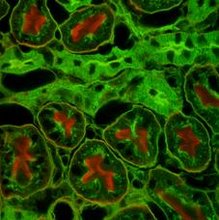Aim: To produce Glutamic acid using Micrococcus Glutamicus.
Requirements:
1. Organism: Micrococcus Glutamicus
2. Inoculum medium:
Glucose 20%
Meat extract 0.3%
Peptone 0.3%
Sodium chloride 0.3%
Distilled water 50ml
3. Production medium:
Glucose 50%
Urea 0.8%
Dipottasium hydrogen
Phosphate 0.1%
Mag. Sulphate 0.025%
Manganous sulphate 0.001%
Ferrous sulphate 0.001%
Protein 60mg/lit
Calcium carbonates 1.3%
Distilled water 100ml
PH 7.2
Procedure:
Content of a 24 hr. culture of M.glutamicus were transferred aseptically in to 50 ml of Inoculum medium. The inoculated broth was placed on shaker at room temp. for 24hr. 10% level of this inoculums was transferred aseptically in to 125 ml of production medium in 500ml conical flask. The flask containing production medium was placed on shaker and samples were withdrawn after 24,36,48,60 and 72 hr. Each sample was tested for PH and PCV and the amount of glucose present. Total amino acid and Glutamic acid content is also estimated.
Estimation of Glucose content:
The estimation was performed by DNS method. Sugar solution in the range of 0.1 to 2.0 mg /ml were used. To each sample 1ml of distilled water and 3ml of DNS reagent were added. The tubes were shaken and heated in the boiling water bath for 3-10 min. Tubes were immediately cooled to room temp. and 3ml of distilled water was added to each tubes. Optical density of the samples was measured at 600nm against the blank, which was prepared by taking 10 ml of distilled water instead of sugar solution. Standard graph was constructed with known concentration of glucose and the results of samples were compared.
Preparation of DNS (dinitro salicylic acid) reagent:
Solution A: 250 gm of Rochelle salt was added to a mixture of 300ml 4.³% Sodium hydroxide and 880ml of 1% DNS.
Solution B: 10 gm of crystalline phenol was mixed with 22 ml of 10% Sodium hydroxide dissolved in distilled water. Volume of the mixture was made up to 100 ml with distilled water and mixed thoroughly.
Solution C: 69 ml of solution B and 6.9 gm of sodium isulphate were mixed thoroughly. Finally solution C was mixed thoroughly with solution A until all the Rochelle salt dissolved. This DNS reagent was stored in well stopperd round glass bottle.
Estimation of total amino acids by colorimetry:
PH of the centrifuged broth was adjusted to 7.0. To 1.0 ml this broth 0.25ml of 1% Ninhydrin reagent was added. The tubes were plugged and heated in a water bath for 10 min. then volume was made up to 10 ml with distilled water. The developed colour was read at 550 nm against a blank solution. The amounts were estimated from the standard graph.
Preparation of 1% Ninhydrin reagent:
1 gm of Ninhydrin was dissolved in 50 ml of water. To this 20 mg of stannous chloride in 50 ml of water was added and solution was mixed well. This solution was allowed to stand in dark for 24 hr. if necessary.
Estimation of Glutamic acid by chromatography:
Descending paper chromatography: The solvent system used in Butanol : Acetic acid : water = 4:1:3. 0.01ml of each of this solvent was placed on a origin line of the paper as dots. After drying the paper was placed in the chromatographic tank. Which was previously saturated with the solvent system. The chromatogram was allowed to run for 16hr.then it was dried in the atmosphere. After drying the paper was sprayed with 0.³% Ninhydrin reagent in acetone solution. The sprayed paper was heated to 80oc in an oven for 10 min and cooled. Spot were observed and developed. These spots were cut off and extracted with 50% alcohol. Optical density was measured at 550nm against a blank solution and with an authentic sample of Glutamic acid 1mg /ml. The optical density reading was extrapolated on a standard graph and the Glutamic acid content of each sample was found out.
Result: The given strain produced a maximum yield of 50% when glucose
Is used as raw material.
Thursday, April 19, 2007
Subscribe to:
Post Comments (Atom)


2 comments:
How can I Estimate plian Glutamic Acid by UV-Spectro or HPLC.
If you know the role of ninhydrine,copper sulphate,pyridine on Glutamic acid estimation by UV-spectro
Hi. Precipitation was observed in my sample + DNS reagent after boiling and cooled when i test reducing sugars content in my acid hydrolysis biomass sample. Why is it so? Thanks a lot!
Post a Comment